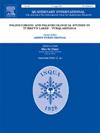Climatic background of aeolian sand accumulation in the proximal sandy deserts/lands and its potential genetic linkage with loess in the Chinese Loess Plateau
Abstract
Sandy deserts/lands along the western edge of the Asian summer monsoon domain are regarded as the major dust source of the East Asia and Pacific Ocean. However, the climatic background of aeolian sand accumulation in sandy deserts/lands and the potential provenance linkage between sand accumulation in sandy deserts/lands and aeolian dusts in the Chinese Loess Plateau (CLP) remains controversial. Based on age data compiled from published studies, we analyze the climatic background of aeolian sand accumulation in the proximal sandy deserts/lands, and the potential linkage between aeolian sand accumulation and the synchronous aeolian dusts in the CLP. The following conclusions are achieved: 1) Aeolian sand accumulation is almost synchronous with the development of loess/palaeosol/lacustrine sediments within the proximal sandy deserts/lands, supporting the idea that in the proximal sandy deserts/lands the aeolian sand accumulated at the high regional effective moisture condition. 2) Coupled with climatic background in neighboring areas, the inconsistent changes during the latest ∼20 ka in accumulation rate between aeolian sands in sandy deserts/lands and loess in the CLP support the idea that the contribution from the proximal sandy deserts/lands to loess in the downwind CLP is limited.

 求助内容:
求助内容: 应助结果提醒方式:
应助结果提醒方式:


